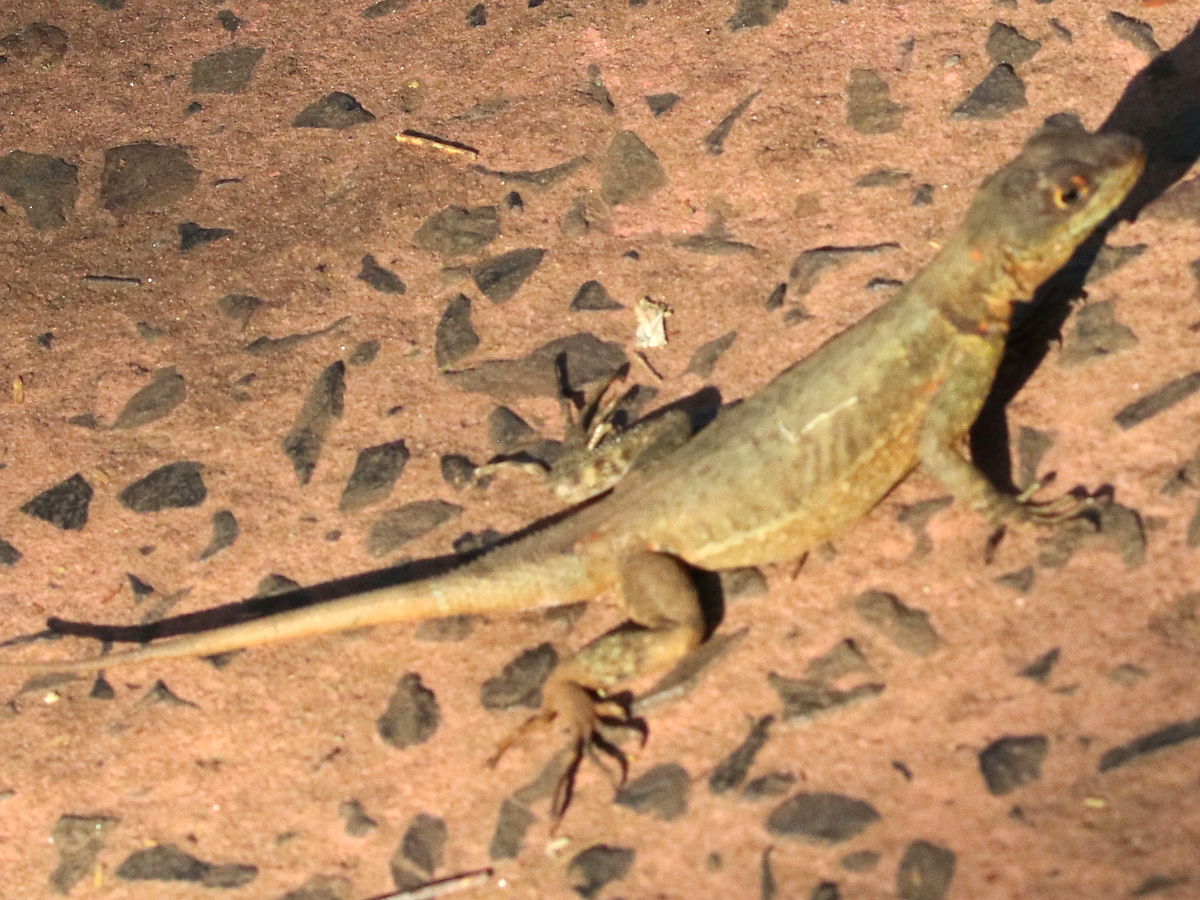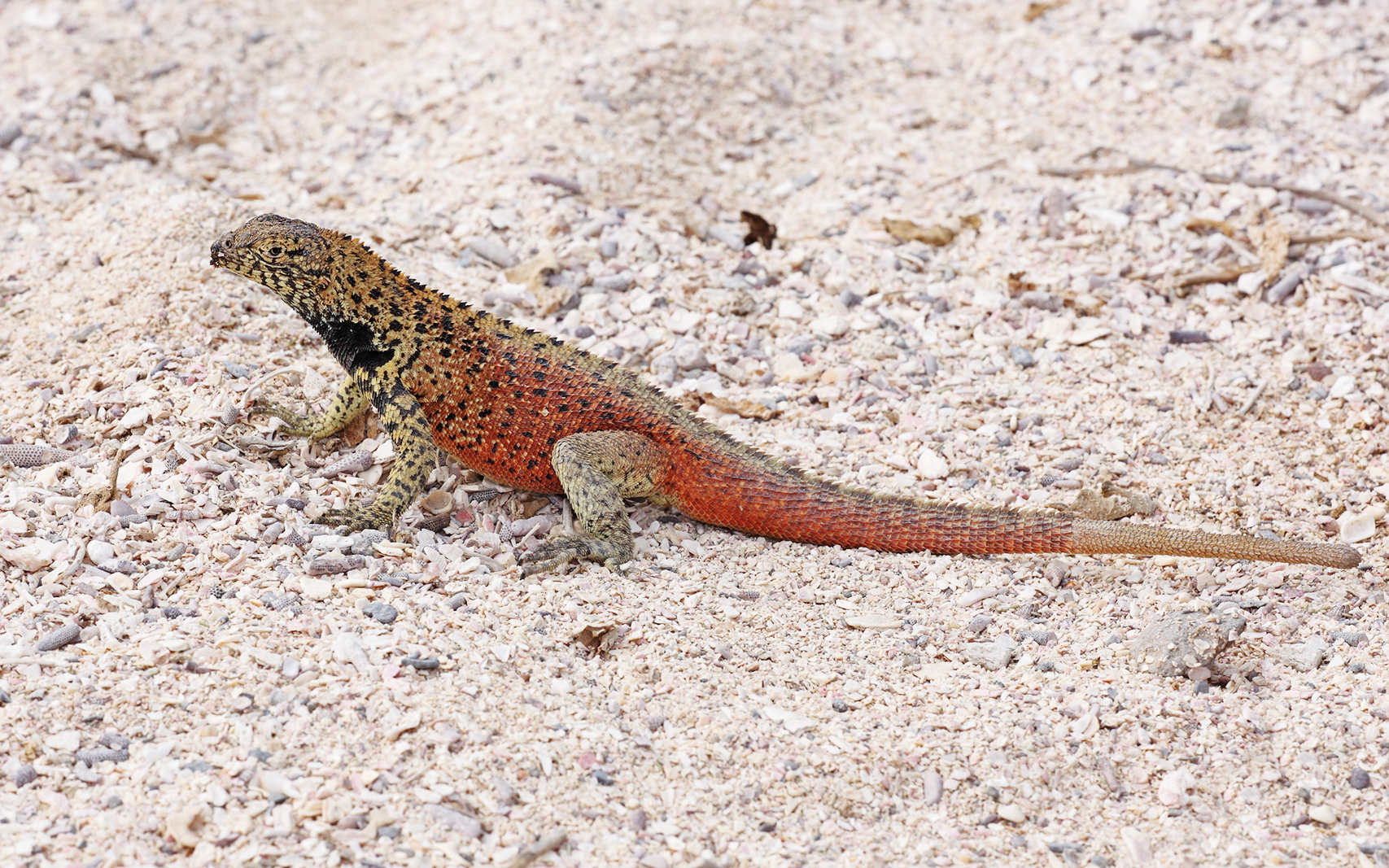|
Tropiduridae
The Tropiduridae are a family of iguanid lizards."Tropiduridae". The Reptile Database. www.reptile-database.org. The family is sometimes considered a subfamily, Tropidurinae. The subfamily is native to South America, including the islands of Trinidad and the Galápagos. Commonly known as Neotropical ground lizards, most are ground-dwelling animals, and the subfamily includes some lizards adapted to relatively cold climates, including those of the Andes mountains and Tierra del Fuego. Several species give birth to live young. A 2021 study described a novel escutcheon-type generation gland ('α-gland') in tropidurines, found in at least 39 species. This gland is believed to be the main potential source of semiochemicals in this group indicating its importance in chemical signalling, an essential component of the communication system of lizards. Genera The family Tropiduridae contains the following eight genera. *'' Eurolophosaurus'' *'' Microlophus'' – lava lizards and ... [...More Info...] [...Related Items...] OR: [Wikipedia] [Google] [Baidu] |
Tropidurus
''Tropidurus'' is a genus of reptiles. The genus includes many species of Neotropical ground lizards (family (biology), family Tropiduridae). ''Tropidurus'' is the type genus of the family Tropiduridae. Geographic range and habitat Species in the genus ''Tropidurus'' are found on the South American mainland, especially in the Amazon Rainforest, but also in more arid regions. Common name No common name is widely used solely for species of the genus ''Tropidurus''. In their native range, they are simply called ''lagartixa'', as are most similar animals. If anything, the Brazilian term ''calango'' is used to particularly refer to lizards of the genus ''Tropidurus''. Taxonomy The genus ''Tropidurus'' contains 30 described species, but new ones continue to be discovered. An additional seven species—the Galápagos lava lizards endemism, endemic to the Galápagos Islands—are sometimes placed here, too, but more commonly separated in the genus ''Microlophus'', instead. Sim ... [...More Info...] [...Related Items...] OR: [Wikipedia] [Google] [Baidu] |
Microlophus
''Microlophus'' is a genus of tropidurid lizards native to South America. Around 20 species are recognized and 10 of these are endemic to the Galápagos Islands, where they are commonly known as lava lizards Benavides, Edgar; Baum, Rebecca; Snell, Heidi M.; Snell, Howard L.; Sites, Jack W., Jr. (2009)"Island Biogeography of Galápagos Lava Lizards (Tropiduridae: ''Microlophus''): Species Diversity and Colonization of the Archipelago". (.pdf) ''Evolution'' 63 (6): 1606–1626. (they are sometimes placed in ''Tropidurus'' instead). The remaining, which often are called Pacific iguanas, are found in the Andes and along the Pacific coasts of Chile, Peru, and Ecuador. The distribution of the lava lizards and their variations in shape, colour, and behaviour show the phenomenon of adaptive radiation so typical of the inhabitants of this archipelago. One species occurs on all the central and western islands, which were perhaps connected during periods of lower sea levels, while one sp ... [...More Info...] [...Related Items...] OR: [Wikipedia] [Google] [Baidu] |
Iguanidae
The Iguanidae is a family of lizards composed of the iguanas, chuckwallas, and their prehistoric relatives, including the widespread green iguana. Taxonomy Iguanidae is thought to be the sister group to the Crotaphytidae, collared lizards (family Crotaphytidae). This family likely first appeared in Cenozoic, previously identified two Cretaceous genera (''Pristiguana'' and ''Pariguana'') are unlikely to belong to this family. The subfamily Iguaninae, which contains all modern genera, likely originated in the earliest Paleocene, about 62 million years ago. The most Basal (phylogenetics), basal extant genus, ''Desert iguana, Dipsosaurus,'' diverged from the rest of Iguaninae during the late Eocene, about 38 million years ago, with ''Brachylophus'' following a few million years later at about 35 million years ago, presumably after its dispersal event to the Pacific Ocean, Pacific. All other modern iguana genera formed in the Neogene period. A phylogenetic tree of Iguaninae is shown ... [...More Info...] [...Related Items...] OR: [Wikipedia] [Google] [Baidu] |
Strobilurus Torquatus
''Strobilurus torquatus'' is a species of lizard in the family Tropiduridae and the only member of the genus ''Strobilurus''. This arboreal lizard is found in the Atlantic Forest in eastern Brazil, ranging from Rio de Janeiro to Ceará Ceará (, ) is one of the 26 states of Brazil, located in the Northeast Region, Brazil, northeastern part of the country, on the Atlantic Ocean, Atlantic coast. It is the List of Brazilian states by population, eighth-largest Brazilian State by .... References Tropiduridae Lizards of Brazil Reptiles described in 1834 Taxa named by Arend Friedrich August Wiegmann {{Tropiduridae-stub ... [...More Info...] [...Related Items...] OR: [Wikipedia] [Google] [Baidu] |
Stenocercus
''Stenocercus'' is a genus of South American lizards, commonly called whorltail iguanas, of the family Tropiduridae. This genus has 80 valid described species. Geographic range The greatest species richness is in Ecuador and Peru, but members of the genus ''Stenocercus'' are also found in Colombia, Brazil, Bolivia, Paraguay, Uruguay, and northern Argentina. Species The following 80 species are recognized, listed alphabetically by scientific name.''Stenocercus'' The Reptile Database. www.reptile-database.org. *'' Stenocercus aculeatus'' ( O’Shaugh ... [...More Info...] [...Related Items...] OR: [Wikipedia] [Google] [Baidu] |
Plica (lizard)
''Plica'' is a genus of tropidurid lizards found in South America and the Caribbean. Species in the genus ''Plica'' are arboreal, medium-sized lizards. Taxonomy For a long time, the genus ''Plica'' was considered to include four species: two relatively widespread ones ( ''P. plica'' and ''P. umbra'') and two tepuis-associated species with narrow distributions ( ''P. lumaria'' and ''P. pansticta''). However, recent research has shown that ''P. plica'' is a cryptic species complex, and four new species were described in 2013. The species count will likely increase as there are still several undescribed species. Species The currently recognized species are the following:. * '' Plica lumaria'' * '' Plica pansticta'' * '' Plica plica'' – collared tree runner, tree runner * '' Plica umbra'' – blue-lipped tree lizard, harlequin racerunner Formerly included in ''Plica plica'': * '' Plica caribeana'' – Caribbean treerunner * '' Plica kathleenae'' – Kathleen's treerunne ... [...More Info...] [...Related Items...] OR: [Wikipedia] [Google] [Baidu] |
Uracentron
''Uracentron'' is a genus of tropidurid lizards found in forests in northern South America. It contains only two species, which are both arboreal, have a relatively short spiny tail, and mainly feed on ants.Avila-Pires (1995). ''Lizards of Brazilian Amazonia (Reptilia: Squamata).'' Zoologische Verhandelingen 299(1): 1-706 Species The Reptile Database *'' Uracentron azureum'' (Linnaeus, 1758) – green thornytail iguana *'' Uracentron flaviceps
''Uracentron flaviceps'', the tropical thornytail iguana or Amazon thornytail iguana ...
[...More Info...] [...Related Items...] OR: [Wikipedia] [Google] [Baidu] |
Eurolophosaurus
''Eurolophosaurus'' is a genus of reptiles belonging to the family Tropiduridae. The species of this genus are diurnal and found in open sandy or rocky habitats in east-central Brazil. Species Species: *''Eurolophosaurus amathites'' – Amathites lava lizard *'' Eurolophosaurus divaricatus'' *''Eurolophosaurus nanuzae ''Eurolophosaurus nanuzae'', Rodrigues's lava lizard, is a species of South American lava lizard in the family Tropiduridae. The species is endemic to Brazil Brazil, officially the Federative Republic of Brazil, is the largest country in S ...'' – Rodrigues's lava lizard References {{Taxonbar, from=Q1965273 Eurolophosaurus Lizards of Brazil Endemic reptiles of Brazil Lizard genera ... [...More Info...] [...Related Items...] OR: [Wikipedia] [Google] [Baidu] |
Thomas Bell (zoologist)
Thomas Hornsey Bell FRS FLS (11 October 1792 – 13 March 1880) was an English zoologist Zoology ( , ) is the scientific study of animals. Its studies include the structure, embryology, classification, habits, and distribution of all animals, both living and extinct, and how they interact with their ecosystems. Zoology is one ..., Dental surgery, dental surgeon and writer, born in Poole, Dorset, England. Career Bell, like his mother Susan, took a keen interest in natural history which his mother also encouraged in his younger cousin Philip Henry Gosse. Bell left Poole in 1813 for his training as a dental surgeon in London. He is listed in 1817 as having an address at number 17 Fenchurch Street, and as being a committee member of the newly formed London Peace Society. By 1819 his address is given as 18 Bucklersbury, also in the city of London. He combined two careers, becoming Professor of Zoology at King's College London in 1836 (on the strength of amateur research) ... [...More Info...] [...Related Items...] OR: [Wikipedia] [Google] [Baidu] |
Prince Maximilian Of Wied-Neuwied
Prince Alexander Philipp Maximilian zu Wied-Neuwied (23 September 1782 – 3 February 1867) was a German explorer, ethnologist and natural history, naturalist. He led a pioneering expedition to southeast Brazil between 1815 and 1817, from which the album ''Reise nach Brasilien,'' which first revealed to Europe real images of Brazilian Indians, was the ultimate result. It was translated into several languages and recognized as one of the greatest contributions to the European knowledge of Brazil at the beginning of the nineteenth century. In 1832 he embarked on another expedition, this time to the United States, together with the Swiss painter Karl Bodmer. Prince Maximilian collected many examples of ethnography, and many specimens of flora and fauna of the area, still preserved in museum collections, notably in the Linden Museum, Stuttgart. The genus ''Neuwiedia'' Carl Ludwig Blume, Blume (Orchidaceae) was named for him. Also, Prince Maximilian is honored in the scientific names ... [...More Info...] [...Related Items...] OR: [Wikipedia] [Google] [Baidu] |
Arend Friedrich August Wiegmann
Arend Friedrich August Wiegmann (2 June 1802 – 15 January 1841) was a German zoologist and herpetologist born in Braunschweig. He studied medicine and philology at the University of Leipzig, and afterwards was an assistant to Martin Lichtenstein (1780–1857) in Berlin. In 1828 he became a professor at University of Cologne, and two years later was an extraordinary professor at the Friedrich Wilhelm University in Berlin. Wiegmann specialized in the study of herpetology and mammalogy. In 1835, he founded, together with other scholars, the zoological periodical '' Archiv für Naturgeschichte'', also known as "Wiegmann's Archive". With Johann Friedrich Ruthe (1788–1859) he wrote an important textbook of zoology called ''Handbuch der Zoologie'', and in 1834 Wiegmann published ''Herpetologia Mexicana'', a monograph on the reptiles of Mexico. In 1841 he died of tuberculosis at the age of 38 in Berlin. His father Arend Friedrich Wiegmann (1771–1853) was a German research ... [...More Info...] [...Related Items...] OR: [Wikipedia] [Google] [Baidu] |





